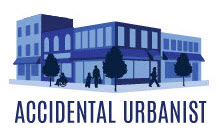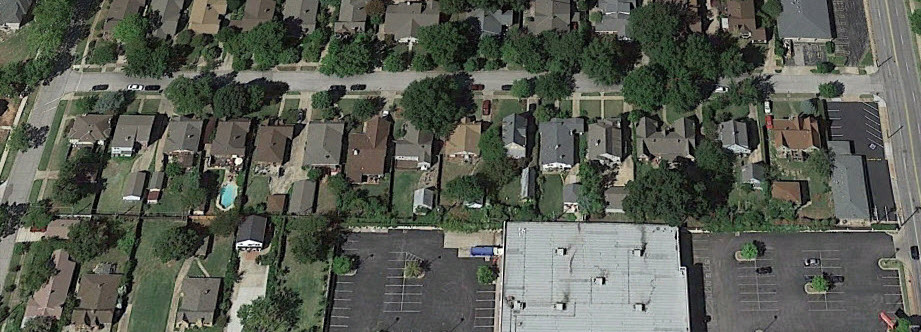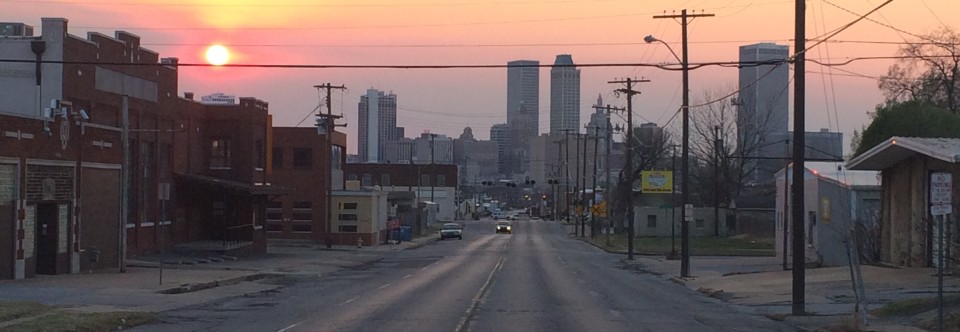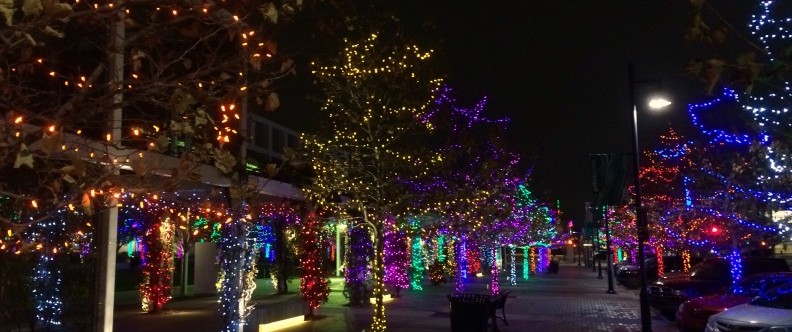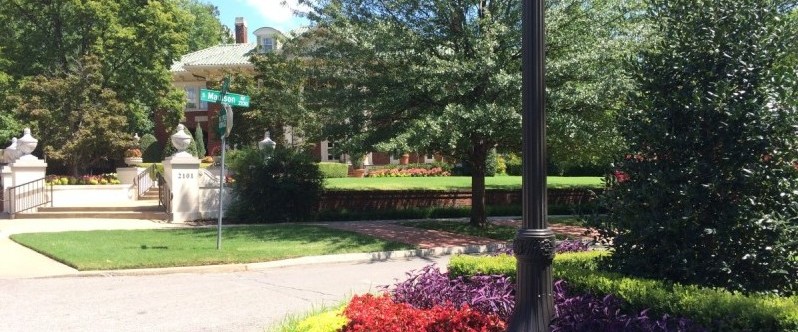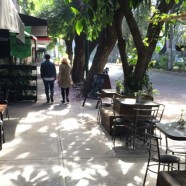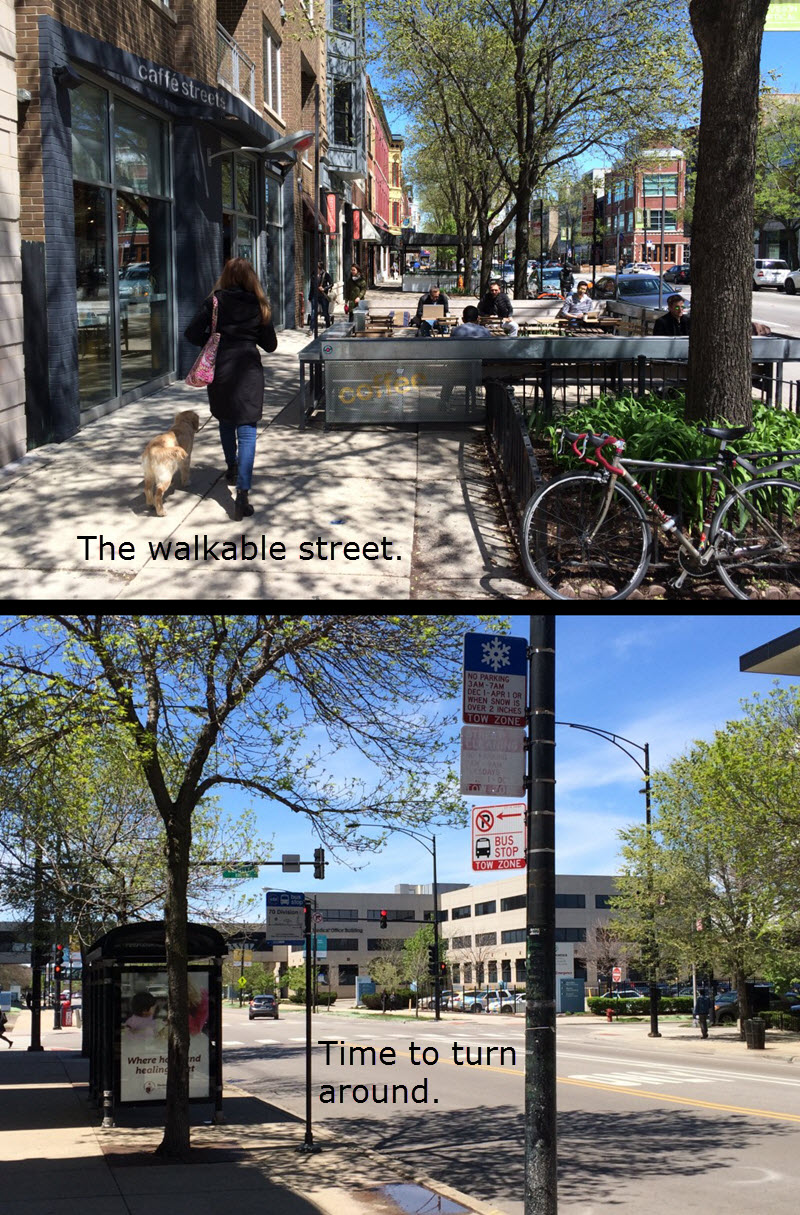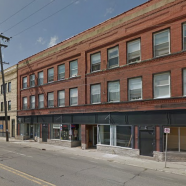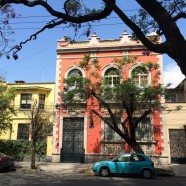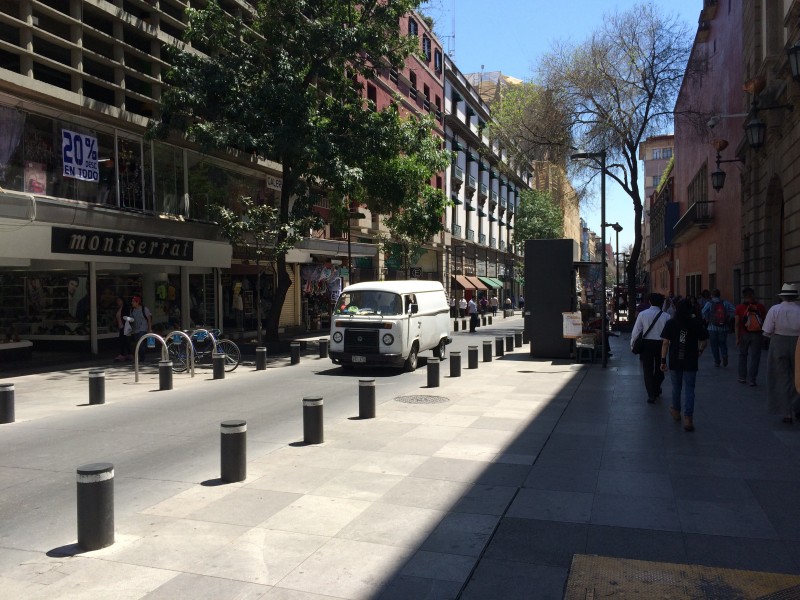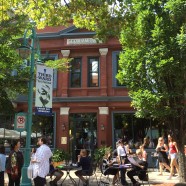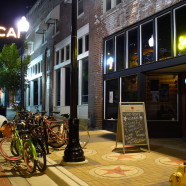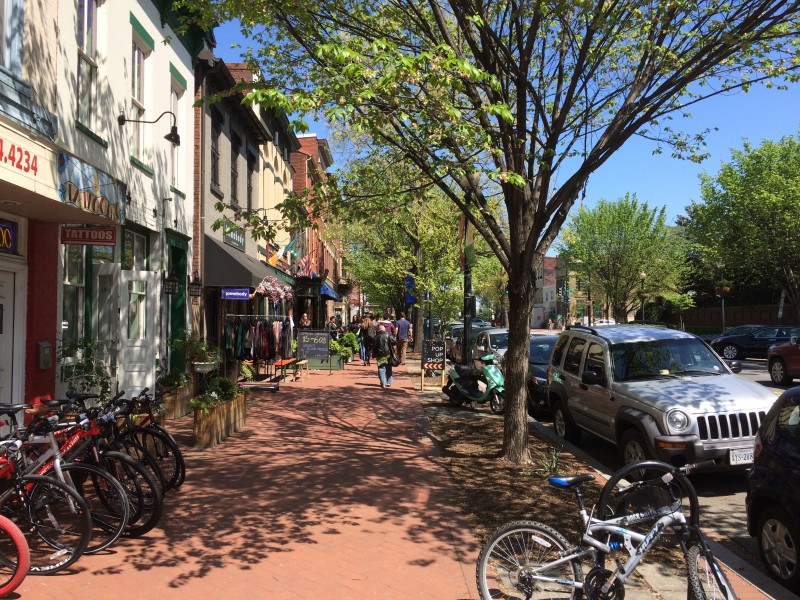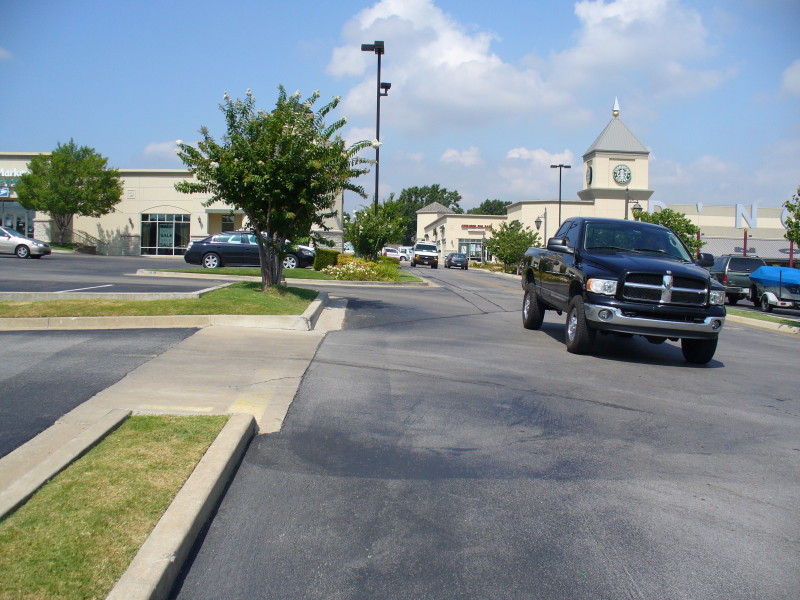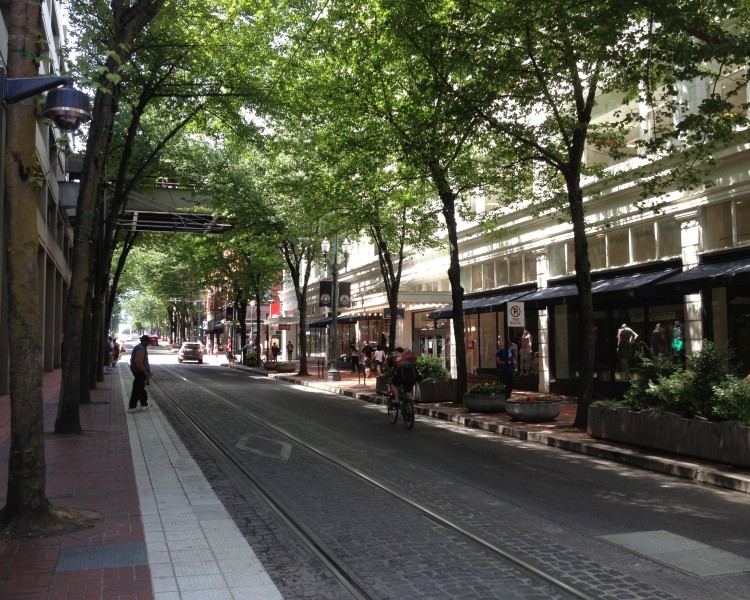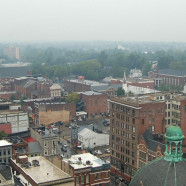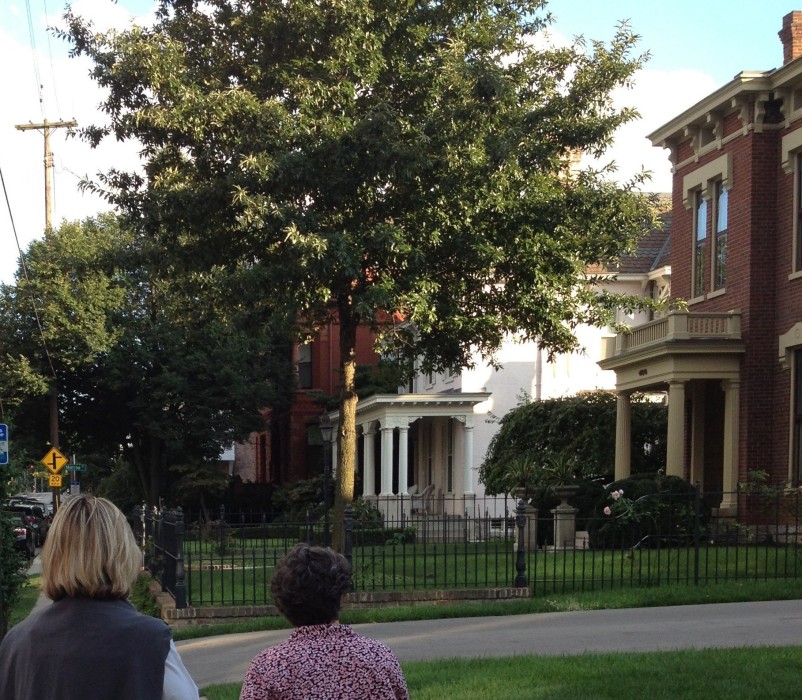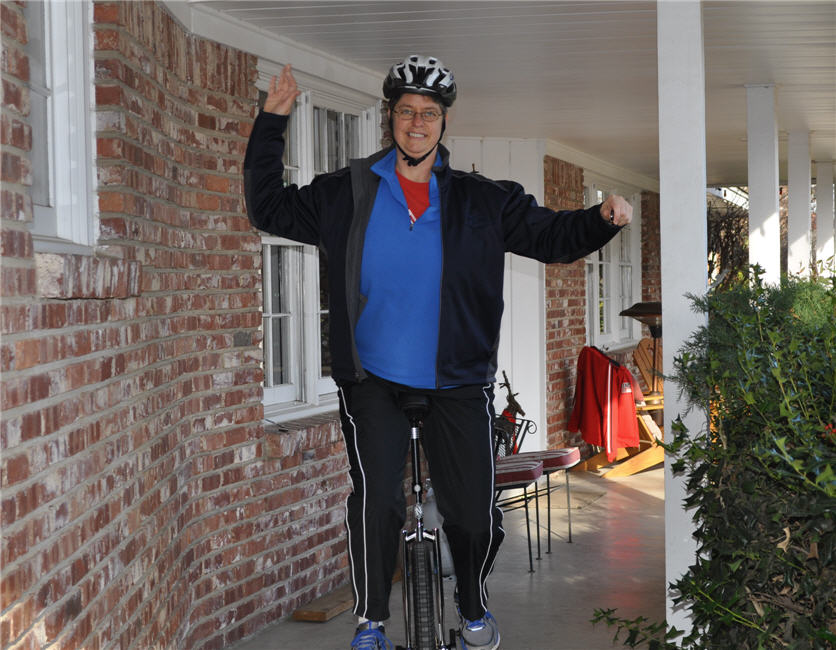What We Know in Our Bones
Walkability is something we understand in our bones. If you feel comfortable and happy on foot, congratulations! You’ve just discovered a walkable place.
The same is true of places that are hostile or unwelcoming to pedestrians: we respond instinctively and are physically repelled by these places. If you’ve ever been walking down a lively street, but stopped and turned around when you came to a blank wall, a drive-thru, a parking lot or other dead spaces, then you’ve experienced it too.
Like Justice Stewart’s famous quote about porn, walkability can be hard to define, but “I know it when I see it.”
We all do.
Read MoreParking Vs. The Walkable Building (The Developer’s Dilemma)
John Anderson (R John the Bad, if you read his blog) is a guy who spent years trying to convince developers to care about walkable urbanism. As it turns out, the “brain damage” wasn’t worth it. A better approach, he decided, was to teach urbanists how to be developers. Which is how I met him last summer at the Congress for New Urbanism’s “Rookie Developers Breakfast.”
I wasn’t the only wannabe who showed up. Overwhelming interest in the topic inspired the creation of a Facebook group called Small Developer / Builders and a series of “Small Developer Boot Camps” led by John, Monte Anderson, and other members of the Incremental Development Alliance.
The lessons they teach would make Jane Jacobs dance on the sidewalk. Start small, keep it simple, build incrementally, foster local tradesmen, provide places for entrepreneurs, take the long view, invest in your neighborhood, and improve it one building at a time.
With each project, you enrich the soil of your “farm,” making the entire area more desirable and livable for you and all your neighbors. Monte Anderson, who has worked this sort of magic in his hometown of Duncanville, TX, calls it “gentle-fication,” a process that brings the community up with you in a gradual and sustainable way.
If you’re a regular Strong Towns reader, this probably makes a lot of sense. After all, this is how cities were traditionally built. People invested in the communities where they lived. Owner-occupants made incremental improvements with the expectation that their legacy would provide lasting value over time. It was never about making hedge fund investors rich from 3rd quarter profits of commodified real estate packages.
This return to an old-fashioned ideal is one of the things that makes small-scale development so appealing—especially to folks like me who care about good urban form, walkable places, and revitalizing neighborhoods. With low overhead and smart choices, it’s actually possible to build desirable places that normal people can afford. These projects help provide crucial “missing middle housing” that the big developers with their high overhead costs simply can’t deliver.
As John Anderson likes to say, “If you’ve ever found yourself eyeing an empty lot and thinking ‘Somebody ought to…’ Well, maybe that someone is you.”
IMPORTANT LESSONS FOR THE SMALL-SCALE DEVELOPER
But there are a couple important lessons that every starry-eyed dreamer/developer must consider.
First and foremost: if you can’t get the rent, you can’t build the building. So when calculating whether or not a project will “pencil,” you start with average rents and construction costs for your area, and work your way backwards to see what’s feasible. Everyone has sexy dreams, but as a developer it’s important to maintain a long-term, monogamous relationship with math.
The second lesson? “Keep it simple.” This encompasses everything from using commonly available construction materials to taking advantage of FHA loans. It also applies to site selection: whenever possible, you want to build “by right” on land that is already zoned for what you want to do.
Unfortunately, this is where a terrific aphorism crashes headfirst into the painful rock face of reality. Because most local zoning codes are ideally suited to building car-oriented crap, they are perfect for folks who like to transform large parcels of land into parking lots, shopping centers, and chain restaurants with drive thrus. Far too often, they conflict with the type of small-scale, walkable places our ancestors would recognize as home.
In cities throughout America, the places we love the best are often illegal to build. If you don’t believe me, test out your hometown zoning code by “building” a project on paper.
KICKING THE TIRES OF YOUR LOCAL ZONING CODE
That’s exactly what we did at a recent Small Developers Boot Camp in Bentonville, AR. We were given a portfolio of development opportunities taken from real life in Kalamazoo, MI. Our package included descriptions of various lots with prices based on comps; a market study of rental rates for commercial and residential spaces; average construction costs per SF; the current zoning for each parcel; and a “plain English” summary of the applicable zoning code requirements. Thus, we were able to compare lots while taking into account market realities and the nitty-gritty zoning requirements that can make or break a deal.
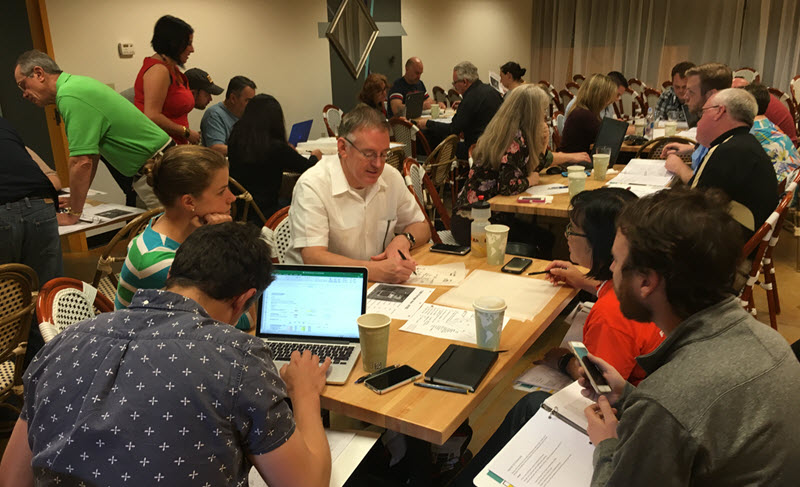 Our mission: Decide what we wanted to build, pick an appropriate lot where we could build it by right with current zoning, and use a pro forma to check the math and see if the project makes money.
Our mission: Decide what we wanted to build, pick an appropriate lot where we could build it by right with current zoning, and use a pro forma to check the math and see if the project makes money.
As aspiring small developers, we first looked for affordable, modest-sized lots, where adding a single building would help complete a missing piece of the neighborhood puzzle. This allowed us to quickly reject big, expensive parcels that were beyond our means.
A glance at the zoning code helped us dismiss other locations.
We wanted the option to build residential over commercial, but this was not allowed in several of the purely residential zoning districts. Minimum Lot Area Per Dwelling Unit (basically, how much land you need per residential unit) and setback requirements (how far back from a lot line you have to build) further limited our choices.
THE DEVIL IS IN THE DETAILS. IT’S ALSO IN TABLE 4.1-A OF YOUR LOCAL ZONING CODE
I have to say, the Minimum Lot Area requirements surprised me the most. We envisioned a compact, mixed-use building with up to three stories and six dwelling units combined with ground-floor retail. But even in a traditional neighborhood where the existing building stock matched our vision, we were limited to three residential units because of this arbitrary restriction.
We would have loved having those extra units, and I’m sure Kalamazoo would have appreciated the extra property taxes our ideal project could have generated—but the code said “no!” (Take that, local schools!)
Ultimately, we decided to test a two-story, mixed-use building with residential above retail, just like the adjacent older buildings, but smaller. For the purpose of our quick estimate, we assumed we would build three 800 SF residential units above 2,400 SF of commercial space on the ground floor, which could be divided into two or three separate storefronts if desired. It wouldn’t maximize use of the space, but it would fill in a “missing tooth” on what was once a lively, walkable street.
PARKING V. BUILDING
Next came off-street parking requirements–and the audible groans and outcries of our merry band of aspiring developers. The parcel we selected was zoned “Commercial Neighborhood” which included a lovely statement of intent: “to promote pedestrian-oriented development” and“encourage small-scale retail sales and personal services to primarily serve nearby residential neighborhoods.”
Of course, nothing says “pedestrian-oriented development” like a vast amount of off-street parking!
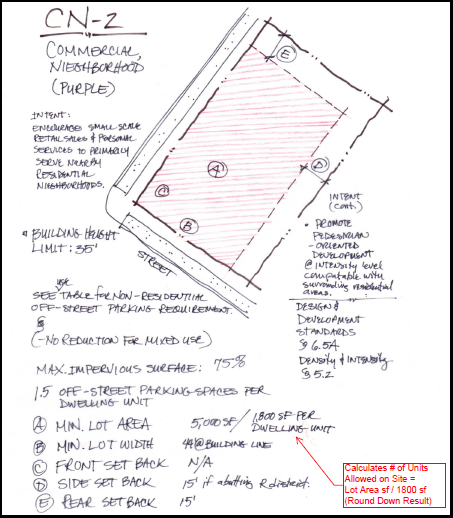 “Let’s make car storage the primary function of our city!” exclaims absolutely no one ever. Unfortunately, the zoning code does. Which is why most cities say they want walkability, but require a ridiculous amount of off-street parking.
“Let’s make car storage the primary function of our city!” exclaims absolutely no one ever. Unfortunately, the zoning code does. Which is why most cities say they want walkability, but require a ridiculous amount of off-street parking.
In our case, each one-bedroom unit required 1.5 off-street parking spaces. Thus, our three apartments needed five total parking spaces (of course, you have to round up). The commercial parking requirements were even worse. It was a moving target based on “use.” Would the commercial space be used as offices? Retail? A coffee shop, restaurant or bar? How could we even know? (None of us brought a Magic 8 Ball to the workshop.)
DOING THE MATH…
The commercial off-street parking requirements ranged from one space per 330 square feet of office floor area to one space per 100 square feet of restaurant. At a minimum, we would be required to provide 7 parking spaces for our 2,400 SF of commercial space. If a tenant wanted to use this space for a bar, we would need 24 parking spaces—because drinking and driving is oddly enshrined in most zoning codes.
All together (calculating residential and commercial) we would need parking for 11 to 29 cars for our little building. And since it takes about 300 SF of land for every parking space (which includes the stall plus associated drive aisles) we would need between 3,300 and 8,700 square feet of land dedicated solely to parking.
Did I mention that our parcel was only 6,752 SF? And we wanted to include a building?
After a lot of sketching and scratching of heads, we managed to fit our building and 10 parking spaces on the lot. Close, but no cigar in our attempt to fulfill the requirements of the zoning code and build “by right.” In real life, that single space we lacked would require a trip to the Board of Adjustment to beg for a variance.
I’LL TAKE PARKING FOR 100, ALEX…
Our story is not unique. Throughout the country, you’ll find zoning codes quite similar to those in Kalamazoo. Because it’s expensive and tedious to overhaul zoning ordinances, they tend to fossilize over time. Unfortunately, many of them appear to be trapped in a geologic formation that includes beehive hairdos, transistor radios, and the 22-volume 1971 World Book Encyclopedia.
Thus, zoning ordinances still require off-street parking to “lessen congestion in the public streets” as if promoting auto travel is a scientifically proven method for eliminating traffic. And while some cities are beginning to reduce off-street parking ratios, only a brave minority have taken the plunge to eliminate them altogether.
So even if those parking spots aren’t needed, they are required. Which basically sucks for everyone except the guy who lays the asphalt. It limits the ability of developers to build small-scale infill projects that contribute to walkable neighborhoods. It incentivizes driving, while punishing people who walk, bike and use transit. And it dilutes property tax revenues because asphalt is never the highest and best use of land.
You’d think this problem would be easy to fix. But if you’ve ever doubted that the pen is mightier than the sword, just try to change a few words in your local zoning code. People will show up in force to protect the status quo as if defending against a zombie apocalypse.
Which is funny, because most folks don’t have a clue what the zoning code actually says or how it impacts their daily lives.
Reading your local zoning ordinance is a powerful soporific; it will induce sleep faster than a Benadryl with bourbon. But it is also, literally, the law of the land—a regulatory document that determines how buildings, neighborhoods and cities will evolve over the coming decades.
If you care about your city’s future, you care about the zoning code.
If we want that future to include small-scale, incremental development that creates walkable places, while building local wealth and improving traditional neighborhoods, we need to make sure our zoning codes enable that vision.
It might be time for a review. Grab a coffee and a copy of your zoning code, and get busy!
Read MoreYou Gotta Go…to Ciudad de Mexico!
If you’re like me, you’ve never given much thought to Mexico City. Sure, back in 7th grade Geography class there were lots of maps to color and world capitals to memorize, but since then? Not so much.
When you talk to Americans about international travel, you’re likely to hear about trips to Europe, or Caribbean cruises, or even African safaris. If anyone mentions Mexico, you can expect to hear about beachfront resorts in places like Cozumel or Cabo San Lucas. But I don’t think I’ve ever heard someone say they were specifically going to Mexico City for vacation.
Which is crazy, because Mexico City is amazing!
In typical clueless American fashion, I had no idea—until an impromptu trip opened my eyes to the wonder of this incredible place. And I am humbled by my ignorance of this city with so much to teach us!
One of my favorite things about travelling is that it challenges your preconceived notions. In this case, my ignorance was so vast, I hadn’t even bothered to have expectations. I knew Mexico City was located at high altitude, and was bigger than NYC. Other than that, I’d been told not to carry valuables or wear shorts. Armed with this “knowledge” I generated a vague mental image that was an amalgam of other places I’d been. I guess I expected a loud, crowded, dirty and possibly dangerous place—kind of a cross between the chaos of Bangkok and the grit of Guatemala City.
Boy, was I wrong!
Continuously inhabited since 1325, Mexico City is the oldest capital city in the Americas, and the largest Spanish-speaking city in the world. The architecture is stunning, the food is exquisite and the people are incredibly gracious and kind. You’ll feel like you’re in Europe, except Mexico City’s friendlier, more affordable, and doesn’t cause jet lag.
It’s a 1.5-hour flight from Houston, and a $300 round-trip ticket from Tulsa on Southwest Airlines. Seriously, it’s easier to get to Mexico City than most places I’ve flown in the United States.
All of which makes it possible to go there for a long weekend (or a week, or a month). Which you should do, because, in addition to being a super cool place, it’s an urban design nerd’s dream destination.
Here are just a few of the things I loved about Mexico City.
Architecture
Mexico City doesn’t demolish their historic buildings after a few decades because they need more parking. This is a city committed to preserving its architectural treasures, even as the ground beneath them shifts mercilessly. (Much of the city center was built upon what was previously a series of lakes. As it turns out, drained lake beds do not create the most stable foundation for enormous stone buildings. Earthquakes haven’t helped, either.)
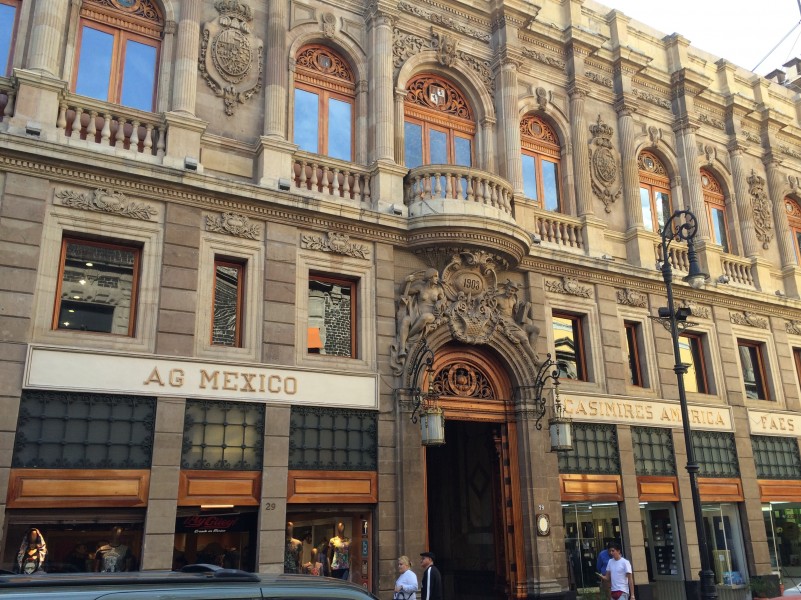
Here you’ll find an impressive array of architectural styles ranging from baroque to colonial to neo-classical to art deco and modern—all built around ancient Aztec ruins. The city exudes a palpable reverence for history, culture and design. Even the public restrooms are gorgeous. Architects and craftsmen are respected. These are my kind of people.
Whimsy
Some neighborhoods are so charming, even their crosswalks are delightful. Seriously? You want to build a wall to separate us from a people whose pedestrian crossings look like this?
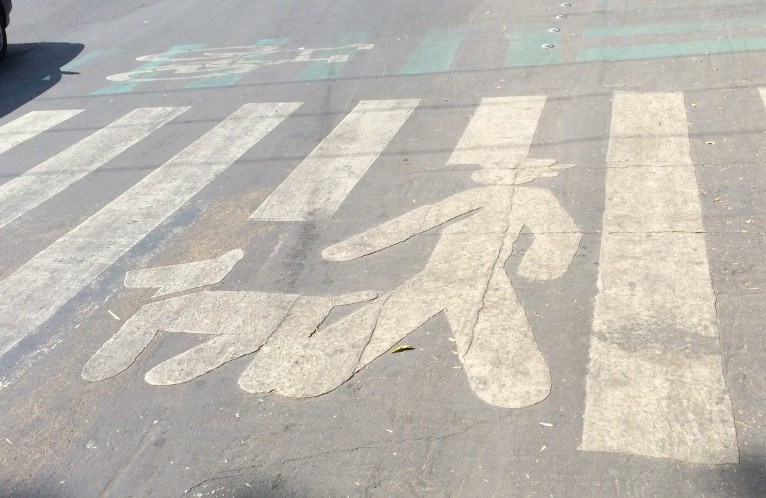
Or this wall inside a restaurant… Yes. It’s a wall.
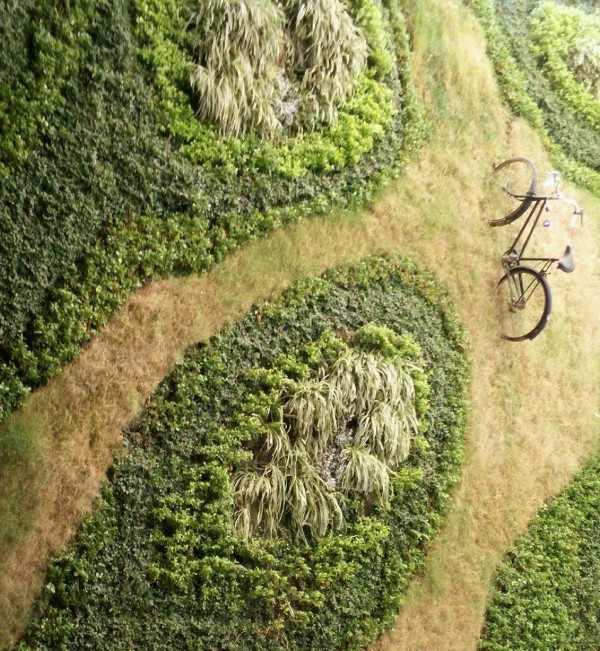
Protected Bike Lanes
Mexico City is also way ahead of us when it comes to creating safe places for cyclists, with over 90 miles of protected bike lanes.
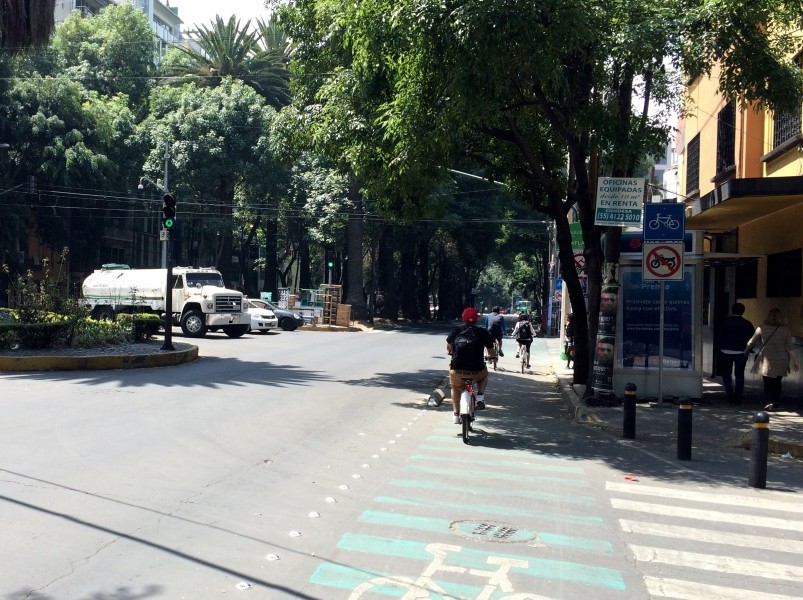
They use wheel stops as an economical way to separate the bike lanes from auto traffic. This protects cyclists far better than striped lanes alone, and dramatically enhances the sense of safety you feel while biking. At the same time, they clearly delineate the cycling lane and send a message that the public right-of-way is for all users, not just people with cars.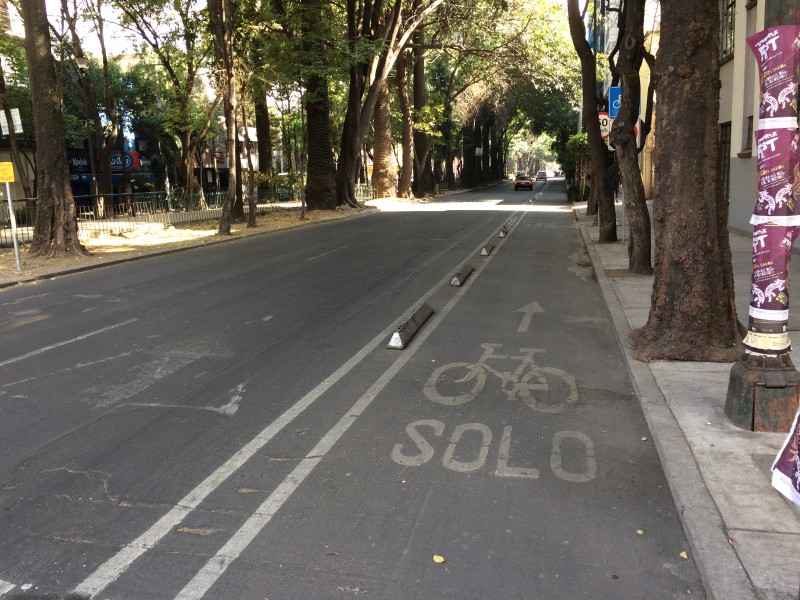
Bike Share
Did I mention that Mexico City has the 4th largest bike share system in the world, with 6,000 bikes at 444 locations throughout the city?
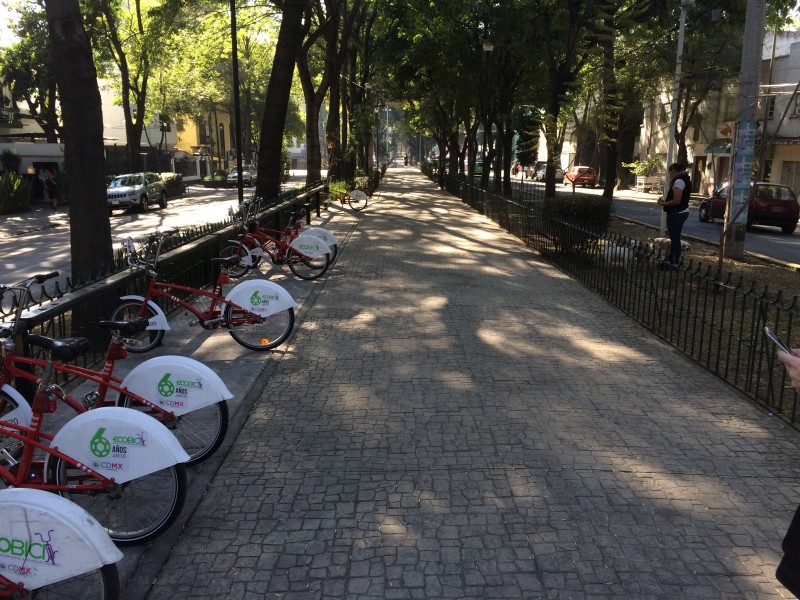
Once a week, on Sundays, they close 35 miles of city streets to cars, allowing thousands of cyclists to flood the roads instead. Or, if you’re hanging out in the Condesa neighborhood, you could ride down these gorgeous boulevards (shown above).
Street Trees
In neighborhoods throughout the city, trees line the streets, offering soothing respite from the sun in this high-altitude metropolis.
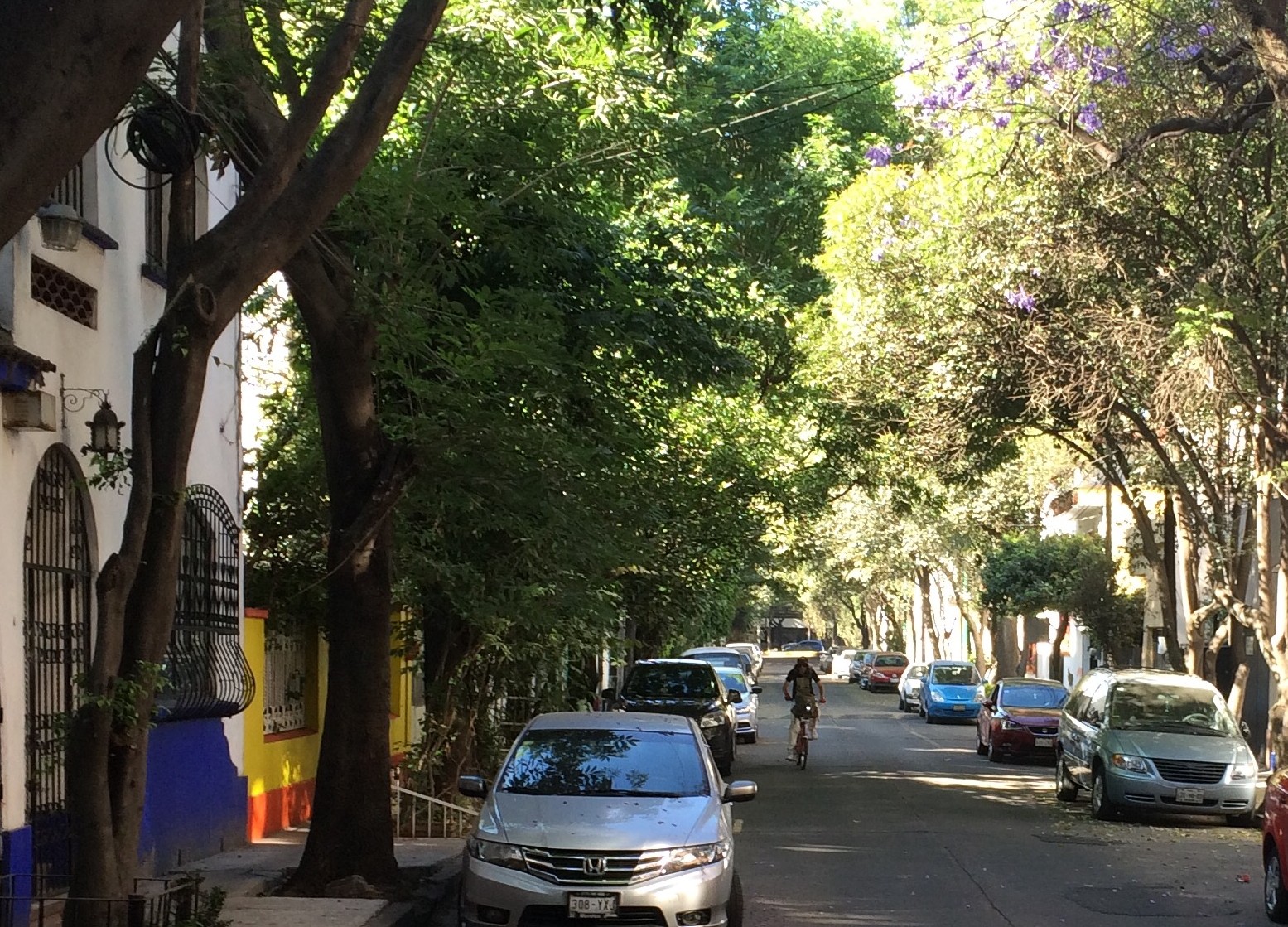
In addition to a long list of environmental benefits, trees planted along city streets make people happy. They calm traffic speeds, provide shade, and form a buffer between sidewalks and cars.
Street trees create human-scaled spaces, soften the sharp angles of a city, and make every avenue feel like a hug. I don’t know how else to explain it, but whether walking or driving, a tree canopy creates intimacy. You feel its protective embrace–while a dose of natural beauty soothes the soul.
Sidewalk Cafes
Sidewalk cafes make neighborhoods more lively, inviting and safe. They put “eyes on the street” and create destinations where you can hang out alone, or engage with others as the mood suits you. Sidewalk cafes bring warmth to the street through the simple act of getting people outdoors–and by sharing the joy of watching people having a good time.
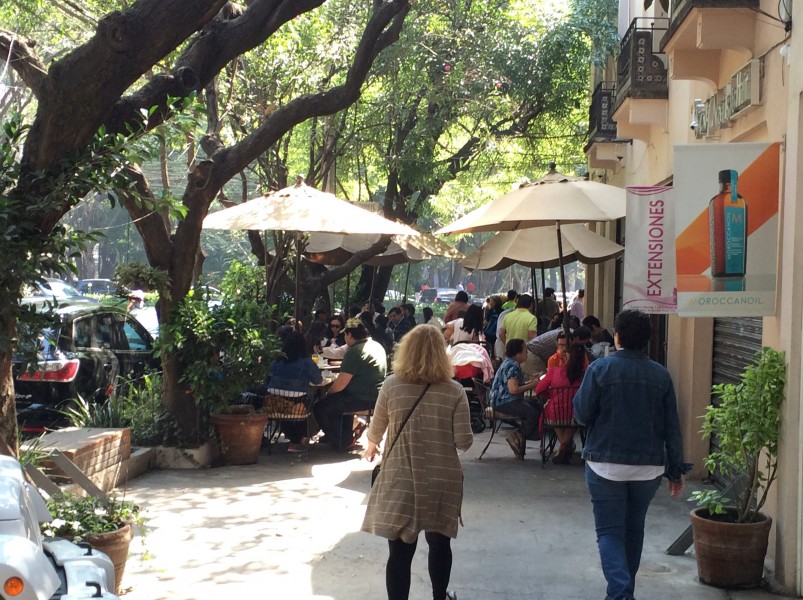
Pocket Parks
In our zeal to create space for cars, we’ve often been overly aggressive with the asphalt. Here’s a lovely little example of what you can do to reclaim those paved areas for people.
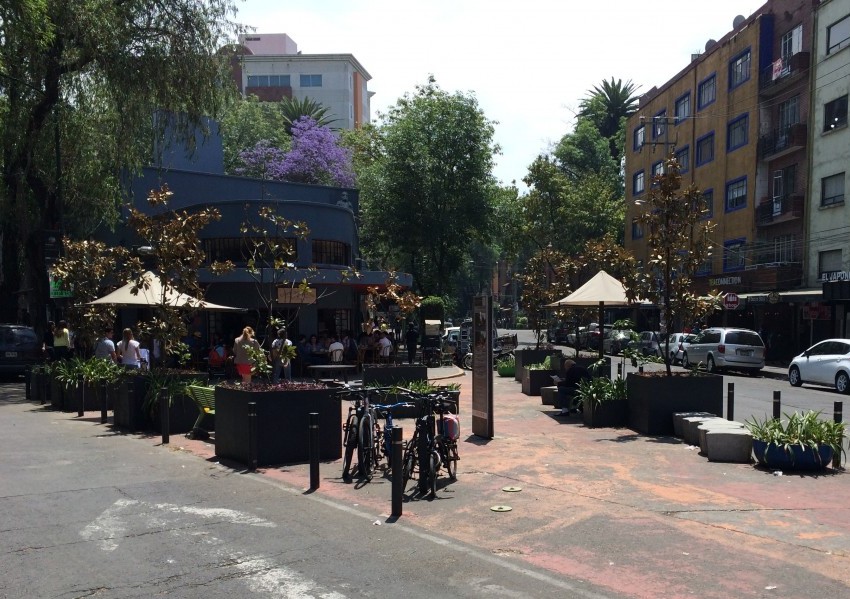
This illustrates what you can achieve when your city has a Public Space Authority dedicated to improving quality of life for all inhabitants. Thumbs up for creating park space for people in an area that was previously utilized only by cars.
Reclaiming Streets for People
Throughout the Centro Historico, many streets have been rededicated to people on foot. As a result, thousands more folks can traverse these public spaces safely and comfortably. Just imagine the misery and congestion if every person in this photo was driving a car!
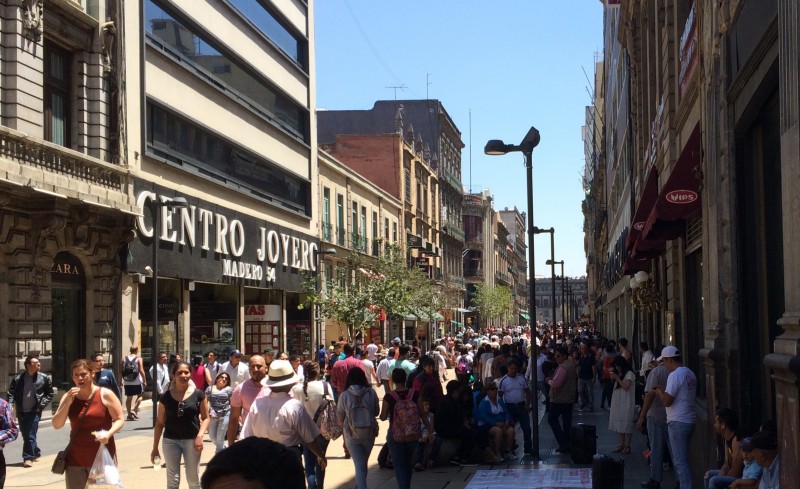
On some streets auto travel is limited to a single lane, with bollards instead of curbs marking the driving route. This sends the message that the street is primarily for people, but essential vehicles can get through. It allows pedestrians to easily cross the street without having to step on and off curbs (a boon to people with physical challenges). And it limits the danger zone where people and cars intersect.
This is what it looks like when you prioritize people instead of cars.
Parks
Did I mention the parks? You’ve got to love a culture that cherishes nature enough to create such dignified and beautiful green spaces.
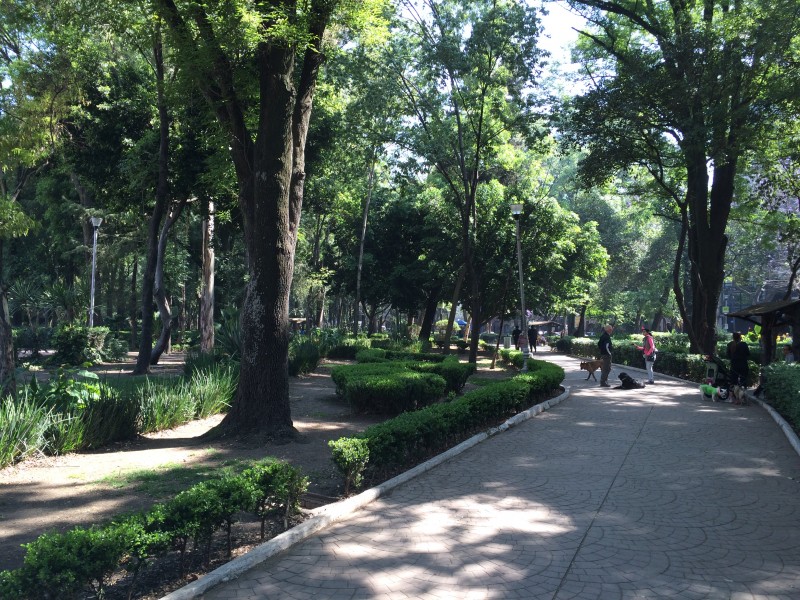
When you enter these magical realms, you can feel your heart rate slow as a sense of peace settles over you. “Biophilia” is the term Edward O. Wilson coined do describe our inherent attraction to nature. Parks play a critical role in the urban ecosystem, reducing stress and increasing the health and happiness of residents.
Plus… free wi-fi!
I could go on and on—about courtyards and colors and casual dining…
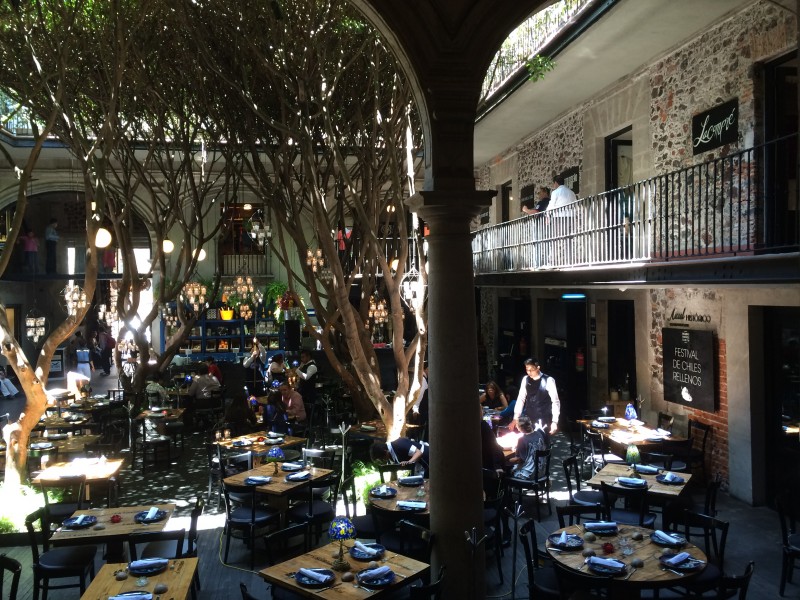
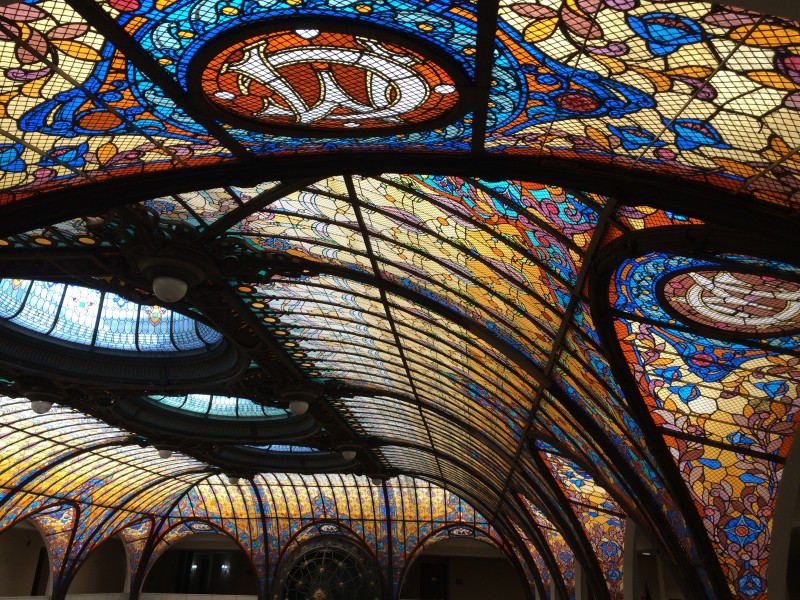

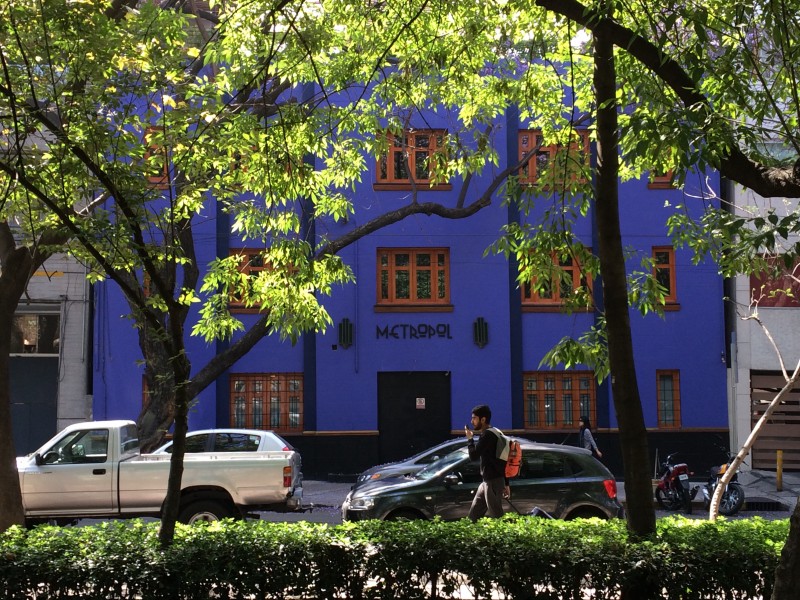
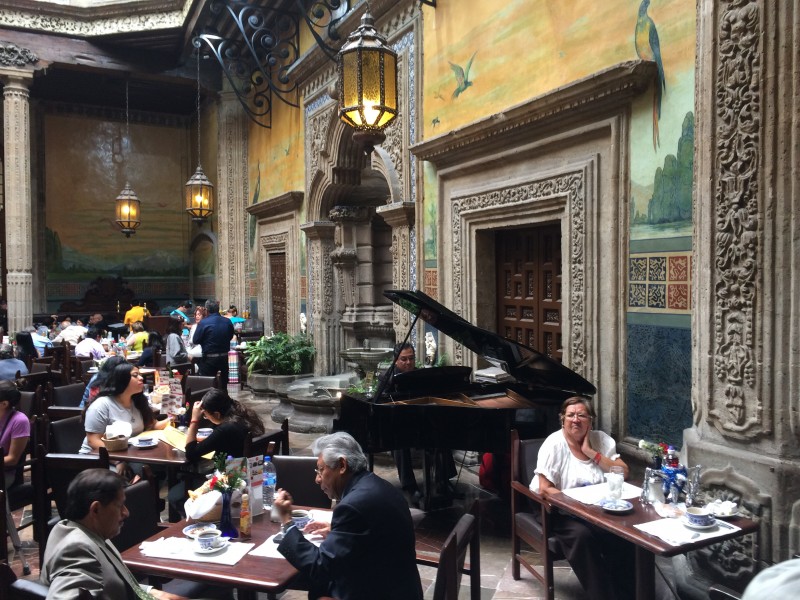
But seriously, what are you waiting for?
Get on a plane and visit this gorgeous city. See for yourself.
Your only regret will be that you didn’t do it sooner.
– Sarah Kobos
Read MoreWant Community? Build Walkability
Lately, I’ve been thinking about how our cities shape our habits and our lives.
Prioritize car travel and parking lots, and you get places where everybody drives. Build places where it’s delightful to walk, and pedestrians magically appear. Make it safe to bike, and cyclists come out of the woodwork.
Drop me in any location—like the “Street View” guy from Google Maps—and I can instantly tell if it’s a good place for people.
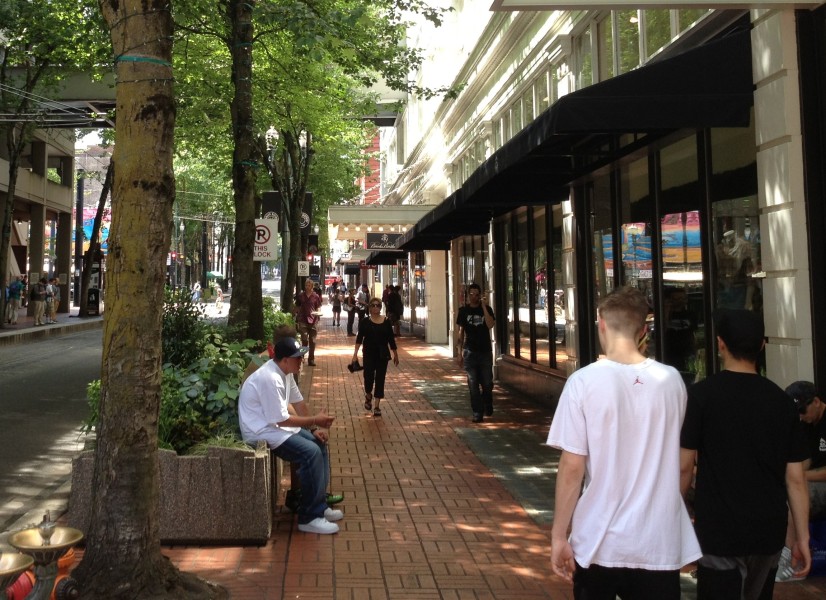
Are the streets narrow enough that drivers slow down and folks feel comfortable on foot? Are the buildings built up to the sidewalk, where pedestrians and transit users can access storefronts without coming into conflict with cars? Is the streetscape interesting to humans, providing a diversity of options and opportunities to explore? Do buildings have sufficient windows to breathe life into the street—allowing people on the outside to see in, and people on the inside to see out?
These are just a few of the variables that make places rich and inviting to people. And for the most part, we quit building them about 70 years ago. Not because people suddenly didn’t want to walk, bike and use transit. We basically regulated walkability out of our cities and towns.
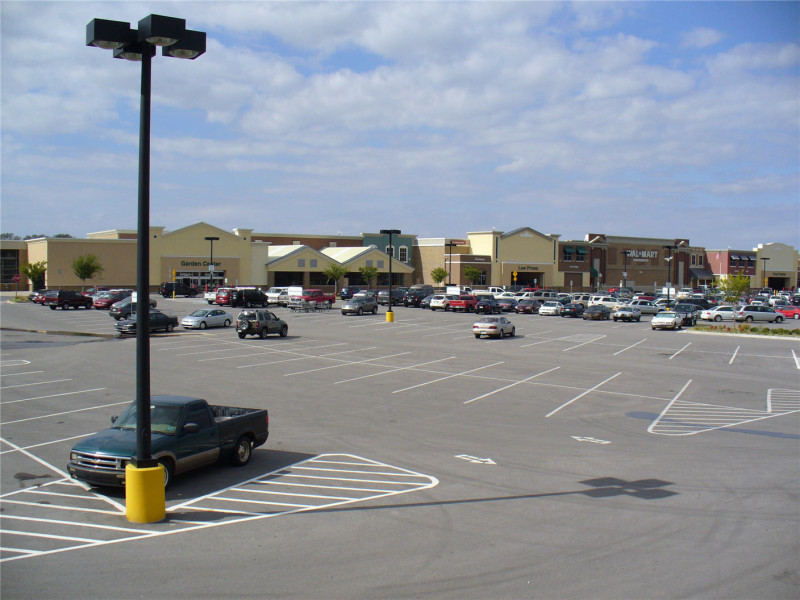
Municipal zoning ordinances separated commercial uses from residential ones, and enshrined car-oriented design at the local level. Transportation engineering standards transformed our city streets into high-speed stroads. Meanwhile, changes to lending practices and federal mortgage insurance regulations made it easy and cheap to get a loan on a single-family home in the suburbs, while making it significantly harder to finance mixed-use buildings in the urban core.
We pay for these mistakes with our bodies, as decades of car-centric design have transformed us from active humans into motorists reliant on machines for movement. But our communities also pay a price, as people who drive are more isolated and detached from the cities they call home.
I don’t mean to knock people who drive. (I live in a city where driving is often the only practical choice.) I simply mean that when you walk or bike, you experience your hometown in a much more intimate way.
NEIGHBORHOODS NEED EYES (AND EARS) ON THE STREET
A few weeks ago, while biking home from work, I was enjoying a long downhill stretch of road late on a Tuesday night. Catching all the green lights is a beautiful thing for a cyclist, and I was pedaling fast.
The sound of breaking glass stopped me.
I braked sharply and circled back, listening and looking for the source of the sound. Unfortunately, it appeared to be coming from the vacant Tulsa Club building, an art deco masterpiece that has suffered from decades of neglect and damage inflicted by vandals, fire, and an absentee slumlord. After many years and several false starts, it’s finally under new ownership and everyone in the community hopes this historic icon can return to its former glory.
Which is why it really ticked me off when I heard a second crash. Someone was either breaking in, or breaking windows for fun.
Without a moment’s hesitation, I was off my bike and yelling at them to stop.
I called the cops, and shined my bike light into the dark passageway between buildings while waiting for them to arrive. When the police showed up, I got back on my bike and headed home. But I kept thinking about what had happened.
If I’d been in my car, I never would have heard a sound. I wouldn’t have stopped, because I wouldn’t have known anything was wrong.
MORE THAN ONE WAY TO GAUGE A COMMUNITY’S HEALTH
When we talk about healthy communities, we often talk about economic prosperity, access to fresh produce, or chronic disease among populations.
But there’s more than one way to gauge a community’s health, and it’s not about dollars or waistlines or longevity statistics. It’s about engaging in your community and being a part of the world around you.
Every time I walk or bike, I enter into this world on a much deeper level.
When I bike to work, I speak to strangers. People say hello. They ask directions. They comment on the weather. At a minimum, I get eye contact and a wave. More often than not, people smile.
Over time, you start to recognize people: The doormen at the downtown hotel. The folks at the bus stop. The kids on bikes delivering sandwiches to office workers. The crossing guard at the elementary school. The homeless guy soaking in the sun on a warm winter day.
As people start to recognize you, the smiles get bigger, and the hellos get friendlier. You start to feel that we’re all in this thing together. Every time it happens, it makes my day. Every time, I feel a part of something bigger and better than myself. Maybe that’s the definition of community.
TRADITIONAL BUILDING PATTERNS BRING PEOPLE TOGETHER
Two things are at play here. One, I’m on my bike. I’m recognizable as a human being. I’m not encased in a soundproof bubble of glass and steel.
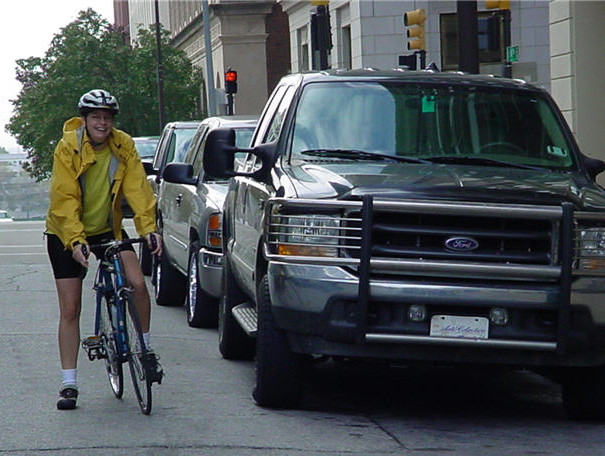
Two, my route to work takes me through older neighborhoods into the heart of downtown. I pass homes and schools and offices and shops, all of which are easily visible from the street. Houses and storefronts are built closer to the street, and there are a lot more people on foot. We’re close enough to recognize each other, and it’s possible to speak.
I rarely bike through places where single-use buildings are fronted by giant parking lots. If I did, I wouldn’t interact with nearly as many people. In these places, I would only interact with cars—which is a lot more dangerous for cyclists and a lot less fun.
But the way we build our cities impacts more than just cyclists. Over the years, I’ve come to believe that older, more traditional development patterns are actually safer and better for everyone.
When buildings “face” the street and meet the sidewalk, not only does it put “eyes on the street,” but walkable places create more opportunities for people to meet, to speak, and to care about each other.
When houses have front porches instead of backyard decks, people are more likely to know their neighbors, at least by sight, and they will notice if anything unusual is happening in the vicinity.
When people live above commercial spaces in mixed-use buildings, they “activate” the space both night and day. The area never feels abandoned, because people are always around.
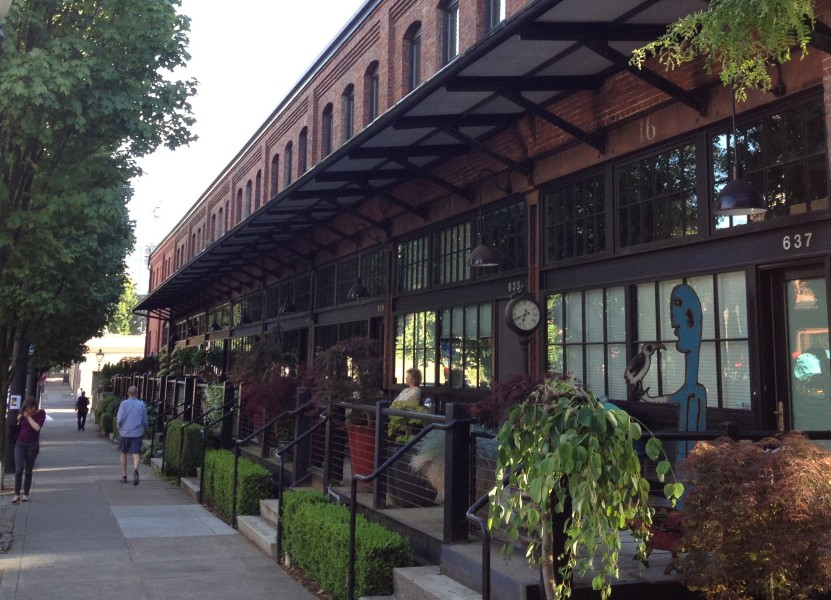
CONTRAST THIS WITH THE SUBURBAN MODEL
In a typical suburban neighborhood, people enter their vehicles within the protective shroud of their garage. They drive to their destinations without speaking to anyone who’s not already on speed dial. They park in enormous parking lots, where they may see other humans, but their main focus is avoiding being run over by an SUV. Later, they return home, where the garage door closes behind them like the drawbridge of a medieval castle. Outdoor activities take place behind privacy fences, and yards are so large that people who can afford to pay others to mow the lawn for them. Neighbors rarely have occasion to speak, and often don’t even know each other’s names.
This doesn’t sound like the American dream to me.
When we stopped building traditional, walkable places, we lost something important: the chance to have routine, face-to-face contact with strangers; and the opportunity to see and know and learn from people who are not exactly like us. In addition, we’ve decimated the kinds of neighborhoods in which people can easily look after each other.
What we’ve done is not good for our communities. It’s probably bad for our souls, too.
I can’t help but believe that our neighborhoods, our cities, and our commitment to each other would improve if more of us lived in places where “bumping into someone on the street” doesn’t involve heavy traffic and a fender bender.
To get there, changes are needed. We need to fix our zoning codes to enable traditional mixed-use neighborhoods. We need to challenge our transportation policies and stop prioritizing car travel over all other modes. And we need to eliminate the regulatory obstacles that make it difficult to obtain financing for renovation or construction of small, mixed-use buildings in walkable neighborhoods.
Cities evolve. We create our future one building at a time. So there’s no time like the present to start building–and rebuilding–places that are great for people and communities (again).
Read MoreAt the Intersection of Fiscal and Physical Health
It’s that time of year again. That brief, exuberant period in January, when gyms are crowded with people whose New Year resolutions haven’t yet expired on Super Bowl Sunday.
Since everyone’s focused on fitness, it seems like the perfect time to talk about healthy cities.
And whether you’re talking about a city’s fiscal health, or the physical health of its citizens, the same rules apply. In fact, you can easily determine if your neighborhood is a fiscally/physically healthy place by answering one, simple question.
When you’re on foot, does it feel good?
That’s it. That’s all you need to know. And here’s why.
When you’re walking and a place makes you feel good, certain conditions are being met. You are probably experiencing a sense of comfort, connection, discovery and delight.
Older, historic parts of town tend to get this right. Here you’ll find interesting architecture, human-scaled buildings, a diversity of destinations, narrow streets, and lively sidewalks.
Because our ancestors traveled on foot, they built for people, and it shows.
Contrast that with how we build today.
If this picture makes you feel exposed, unsafe, disconnected and anxious…congratulations! You’re human! If you think a lot of space is being wasted, you’re also correct. And if it you would never choose to walk to this destination, you’re not alone.
Which gets us back to the connection between fiscal and physical health, and the magic of traditional development patterns.
Those old geezers really knew what they were doing.
If your town has an intact, historic Main Street, then you have a terrific example of what I mean by traditional development. These neighborhoods weren’t planned to meet a single purpose for a single developer (for example: “regional shopping center”). Instead, they grew up organically over time to meet the varied needs of many different people, all of whom lived nearby and traveled on foot.
And because these places were built before car-centric development became a fad, they are much more efficient at utilizing space.
In traditional neighborhoods, buildings abut the sidewalk, and narrow storefronts stand shoulder to shoulder along the street. This eliminates wasted space and shortens the distance between destinations. It also creates the perfect environment for window shopping. Meanwhile, two- and three-story buildings allow a mixture of uses, while doubling or tripling the amount of usable space on modest-sized parcels of land.
As it turns out, these unassuming little Main Streets are turbo-charged economic engines that generate an incredible amount of tax revenue per square foot. And because they utilize space so efficiently, it costs a lot less to provide and maintain the public infrastructure they require.
And then there’s the alternative.
Compare that to the super-sized, asphalt wastelands that comprise 99% of all new development today. Single-story, single-use developments that are spread apart by great distances result in far higher public infrastructure costs while generating a lot less tax revenue per square foot of land.
This is the modern development pattern that Chuck Marohn calls the Suburban Experiment, and it’s crippling municipalities.
But it’s not just bad for your city’s bottom line.
All that waste is bad for your waist, as well.
Why? Because those very same factors that make car-centric developments terrible for city coffers also make them bad for your physical health.
Meanwhile, the very qualities that make traditional developments efficient economic generators also tend to create neighborhoods where you can easily use your muscles to get from place to place.
Where would you rather walk or bike?
Here?
Or here?
All that free parking is making you fat.
There’s a word for our modern, suburban style of car-centric development: “obesogenic,” which literally means “tending to cause obesity.”
We don’t simply create places where people aren’t encouraged to walk. We create places that punish people who try.
Wide streets with fast moving traffic make drivers happy, but they’re deadly to pedestrians. Buildings located far from the street provide lots of space for parking, but make it impractical for people to walk, bike or use transit to reach their destinations. (They also create asphalt moonscapes that are inhospitable to humans and lousy for the environment.) Separation of uses–like segregating residential from commercial, and office from retail–means that everyone must travel even further to meet their daily needs.
These are places where only the most desperate individuals venture forth without the protective carapace of a car. But you can’t blame folks for driving. In these environments; it’s often the only rational choice.
And yet, when you place those very same people in neighborhoods that were built for folks on foot, an amazing thing occurs.
People walk.
And when people start walking and biking, even to run a few short errands, another magic thing happens. Suddenly, they get the recommended 30 minutes of daily exercise, without even trying.
Because when you live in a walkable place, you don’t just run errands, you burn calories. You also increase your brain function, reduce the risk of chronic disease, strengthen your muscles, improve your balance, shrink your waistline, and extend your life.
But beyond that, when people get out of their cars, they connect with people.
Instead of your daily commute being a time of stress and frustration, you get some fresh air and sunshine. You cross paths with people and smile. You speak to strangers. You open your life to happenstance and serendipity. You notice beauty.
And you never have to go to the gym.
Read MoreAre You an Accidental Urbanist?
Somewhere along the way, I became an urban design nerd.
I’m fascinated by cities: how they’re built; how people get from place to place; and, most importantly, how I feel as a human being in that space.
My hobby drives my friends crazy. I’m constantly babbling about sidewalks, pocket parks, street widths, setbacks, parking requirements, and protected bike lanes. Also, I use the word “fenestration” in sentences.
In case you’re wondering (I know, you’re not) fenestration refers to the openings on a building–windows, doors, etc. It’s the thing that allows window shopping and people watching to occur. And it’s super critical to successful neighborhoods and streets.
But I digress.
As a kid, I was fascinated by old things. I loved old houses, old buildings, old objects, old people, and old ways of doing things. But I didn’t start thinking about cities, per se, until I found myself living in downtown Lexington, KY one summer during college.
Suddenly, a new world opened up before my eyes.
It was the first place I’d ever lived where walking was a valid form of transportation. Because Lexington was founded in 1775 and came of age in the 1800’s, it developed during a time when streets and neighborhoods were built for people who walked.
Here was a place where you could step out the door and stroll to an infinite variety of destinations. Parks, shops, restaurants, bars, schools, hardware stores…everything was within walking distance. Better yet, every step of the way was beautiful and interesting.
Because here’s the thing: when you’re walking, beauty matters. You notice details. You care about architecture. You stop for flowers. You laugh at quirky window displays. You appreciate art.
The result? Places built for people who walk are better places.
In the olds days, we got this right by default. We traveled at a walking pace and cities were built to satisfy the needs of people.
Although we’ve spent the past 60 years designing our cities primarily for the movement and storage of automobiles, we know there’s a better way. We can see it in our historic city centers and older neighborhoods. And we see it in newer developments where people cherish a sense of place.
So let’s talk about what it takes to make cities and neighborhoods great again.
You might discover that you’re an Accidental Urbanist, too!
Read MoreZen and the Art of Unicycle Riding
Although this blog is supposed to be dedicated to urban design, transportation and land use, today it’s going to be about something even more geeky and esoteric: learning how to ride a unicycle.
Let’s call it “alternative transportation,” and pretend it counts. I’m hoping the blog police will let me off with a warning.
Where to begin?
Like most folks, I’ve seen a lot of people ride unicycles—circus performers, jugglers, the kid who delivered our paper in the 70’s—but I’d never tried it myself until a few years ago. I was visiting a friend whose nieces owned a small, yellow “uni,” and I simply had to give it a shot. While my attempts to ride it were laughable, I was intrigued.
At first glance, a unicycle looks like some sort of early prototype that should have been abandoned shortly after the invention of the wheel. At second glance, it makes even less sense. Under no circumstances does it seem like a practical approach to personal transportation.
And yet, it’s the improbability that makes unicycling so appealing.
Three years after seeing that little yellow unicycle, and about a month after my 48th birthday, I finally bought one.
Now, if I could just ride the darn thing.
Embrace the process.
Unicycling is not a hobby for those seeking instant gratification. Achievements occur at the nano level, so you have to be able to discern tiny, incremental improvements—then celebrate them with all your might.
You also have to be willing to look like a complete dork.
They say it takes between 15 and 30 hours of dedicated practice to become competent on a unicycle. You will look like an idiot during most of that time. But as a friend said: “What’s 30 hours of frustration compared to the kick-ass reality of being able to ride a unicycle for the rest of your life?”
So true. And since I needed a new challenge, it’s been a fun diversion. Really, this whole unicycle thing is turning out to be a metaphor for life.
Here are some of the lessons I’ve already learned:
Feeling terror just means you’ve made a healthy decision to step outside your comfort zone.
The first time you attempt to balance on a unicycle, your body (correctly sensing a threat to life safety) floods your cells with adrenaline, leaving you shaky and trembling. The following day, you’ll be sore in 38 different muscles you didn’t realize you had. This is merely a sign that you haven’t been living up to your potential. Sitting at your desk isn’t cutting it. Maybe it’s time to try more things and shake it up a bit!
You’re also sore because…
Fear takes energy.
I can’t begin to express just how impossible unicycling seems at first. You are keenly aware that the unicycle is a slippery devil, disobedient to your will, and bent on your destruction. For this reason, you tend to clench parts of your body that have rarely been tensed. It’s exhausting. Try to relax. There’s enough going on without adding unnecessary stress.
You have to move in the direction of your dreams before you can get there.
Unicycling is about having the courage to lean forward into nothingness, and trusting that your legs can pedal fast enough to keep the center of gravity beneath you. The difficulty is that once you’ve finally learned how to balance in place on a unicycle, it starts to feel comfortable and safe. Your body naturally wants to remain in this position of security. But the only way to get anywhere is to lean forward and go. So you have to tip ever so slightly forward—which feels exactly like falling—and start pedaling.
If you think about it, this is precisely how everyone learns to walk. We’ve simply forgotten the lessons of toddlerhood: Be brave! Don’t just stand there, go someplace! Lead with your heart. Falling is part of the process. And remember to celebrate each and every little step along the way.
Brute force doesn’t work.
This one’s difficult to explain. In the beginning, one of the hardest things is to simply rest your weight on the seat. This is scary because the unicycle is a tipsy and unreliable vessel, poised to flop in any direction at any time. But the pedals are “fixed” to the wheel, which is oddly comforting. The pedals appear to be the only thing you might be able to control. So you’ll be tempted to try to exert your will through them using every muscle in your legs.
But here’s the catch. Trying to balance delicately on something while exerting brute force with the largest muscles of your body is difficult and exhausting. You’re also wasting a lot of strength pushing down, when your goal is to go forward.
The answer is simple and elegant. Like the song says, “Let it go!” (I know, I know. Sorry.) Don’t fight with the thing, just sit on it. Really sink into the seat. For some reason, as soon as you do this, everything becomes easier. Since you’re no longer exerting brute force, you can relax and feel your balance. And because you’re not putting all your weight on the pedals, ironically, pedaling becomes much easier and more fluid. As soon as you stop fighting it, you start getting somewhere.
It’s better when you just go for it.
Weirdly enough, when you hold back, you’re much more likely to fall than when you just go for it. Due to some physics that I can’t explain about centripetal force and inertia and who knows what else, the unicycle becomes a lot more stable as soon as you start pedaling. Anyone who’s ever ridden a bike knows this. You can cycle comfortably all over town as long as you’re moving. But if you try to balance on the bike while stopped at a stoplight, it becomes incredibly hard to stay upright. So once you get started, keep going! Momentum is your friend.
Doubt doesn’t help.
Eventually, you’ll experience a moment where you think: “Hey, this is working! This feels right! I’m doing it!” which is inevitably followed by: “Holy crap! This is scary! I can’t do this!” Doubt creeps in. You get nervous and pull back. Which immediately causes you to dismount. And by that I mean fall/jump off. Try to hold onto that other feeling. The one that, for just a split second, felt like grace. Focus on your successes, not your fear and failures.
Life is about incremental progress.
So here’s where we can bring this whole thing back to cities and urban design.
In many ways, my unicycling skills mirror my hometown’s early attempts at complete streets and smart urban design. We’re not there yet, and mostly we don’t know what the hell we’re doing, but we’re making small, incremental progress. We make a lot of mistakes, but we’re starting to do some things right.
In Tulsa, we’ve updated the zoning code, which will allow smart people to build better places by right, not via special exception. We’ve reduced minimum parking requirements, which will help entrepreneurs who want to revitalize old buildings in historic parts of town. Our city engineers are beginning to understand what complete streets are, and they’re starting to think about bike lanes and sidewalks as critical components of the public right-of-way. People are beginning to talk about the harsh economic realities of sprawl and car-centric design. And soon, we’ll be updating our subdivision regulations, to ensure neighborhoods are designed for connectivity, not cul-de-sacs.
We have a long way to go before we master this thing, but in between our mistakes, we’re doing more and more things right.
It’s progress. I’m learning to respect that.
Happy New Year! Keep pedaling!
by Sarah Kobos
Read More